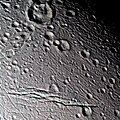File:EN004 Painting on the walls.jpg

Original file (1,000 × 1,000 pixels, file size: 442 KB, MIME type: image/jpeg)
Captions
Captions
Summary edit
| DescriptionEN004 Painting on the walls.jpg |
English: False-color view of Enceladus. Dunyazad crater is the large crater just left of top center.
Original caption released with image: During its closest flyby of Saturn's wrinkled, icy moon Enceladus, Cassini obtained multi-spectral images of its cratered terrain that have been composited to create this False-color view. To human eyes, Enceladus appears almost completely white, but false-color reveals intriguing details. This view is a composite of images taken using filters sensitive to ultraviolet (centered at 338 nanometers), green (centered at 568 nanometers), and near-infrared (centered at 930 nanometers) light, and has been processed to accentuate subtle color differences. The uppermost surface of these terrains appears uniformly grey in this picture, suggesting that they are covered with materials of homogeneous composition and grain size. However, the walls of many of the fractures appear to be somewhat bluer than typical surface materials. It is possible that the difference in color identifies outcrops of solid ice on the walls of fractures, or ice with different grain-sizes, compared to powdery surface materials. It is also possible that the color identifies some compositional difference between buried ice and ice at the surface. The surface is peppered with craters of all sizes, from the 21-kilometer (13-mile) diameter crater at the top of the image, down to tiny craters near the limit of resolution. The prominent crater at the top contains a central, domelike structure that is over 11 kilometers (7 miles) in diameter. The dome, the crater – and indeed the entire scene – is sliced by a complex network of fractures ranging in width from hundreds of meters in some places, to over three kilometers (2 miles) in others. The prominent, complex fracture in the bottom of the frame extends over 85 kilometers (53 miles) in length across the field of view. From Cassini's oblique vantage point, the walls of the large fracture are clearly visible. A pervasive network of narrow, parallel grooves can be seen in many places in the image, and they appear to slice the surface into parallel slabs of ice approximately 500 meters (1,600 feet) in thickness. The image has been rotated so that north is at the top of the scene. The terrain in this scene is located on the side of Enceladus that faces away from Saturn, centered on latitude 28.7 N, longitude 192.5 W. The image was taken during Cassini's closest-ever approach to Enceladus on March 9, 2005. The image was taken with the narrow angle camera from a distance of approximately 21,300 kilometers (13,200 miles) from Enceladus and at a Sun-Enceladus-spacecraft, or phase, angle of 45 degrees. Resolution in the image is about 130 meters (430 feet) per pixel. |
| Date | |
| Source | http://www.nasaimages.org/luna/servlet/detail/NVA2~1~1~846~100887:Painting-on-the-Walls; http://photojournal.jpl.nasa.gov/catalog/PIA06210 |
| Author | NASA/JPL/Space Science Institute |
| Other versions |
 |
This image or video was catalogued by Johnson Space Center of the United States National Aeronautics and Space Administration (NASA) under Photo ID: PIA06210 and Alternate ID: SPD-SATRN-1434. This tag does not indicate the copyright status of the attached work. A normal copyright tag is still required. See Commons:Licensing. Other languages:
العربية ∙ беларуская (тарашкевіца) ∙ български ∙ català ∙ čeština ∙ dansk ∙ Deutsch ∙ English ∙ español ∙ فارسی ∙ français ∙ galego ∙ magyar ∙ հայերեն ∙ Bahasa Indonesia ∙ italiano ∙ 日本語 ∙ македонски ∙ മലയാളം ∙ Nederlands ∙ polski ∙ português ∙ русский ∙ sicilianu ∙ slovenščina ∙ Türkçe ∙ українська ∙ 简体中文 ∙ 繁體中文 ∙ +/− |
Licensing edit
| Public domainPublic domainfalsefalse |
| This file is in the public domain in the United States because it was solely created by NASA. NASA copyright policy states that "NASA material is not protected by copyright unless noted". (See Template:PD-USGov, NASA copyright policy page or JPL Image Use Policy.) |  | |
 |
Warnings:
|
Original upload log edit
- 2005-06-03 01:20 Volcanopele 1000×1000× (452341 bytes) [[False-Color]] view of [[Enceladus (moon)|]]. [[Dunyazad (crater)|]] [[Impact crater|crater]] is the large crater just left of top center. '''Original caption released with image:''' During its closest flyby of [[Saturn (planet)|]]'s wrinkled, icy moo
File history
Click on a date/time to view the file as it appeared at that time.
| Date/Time | Thumbnail | Dimensions | User | Comment | |
|---|---|---|---|---|---|
| current | 01:52, 12 January 2012 |  | 1,000 × 1,000 (442 KB) | OgreBot (talk | contribs) | (BOT): Uploading old version of file from en.wikipedia; originally uploaded on 2005-06-03 01:20:58 by Volcanopele |
| 16:37, 9 August 2005 |  | 600 × 600 (120 KB) | Changcho~commonswiki (talk | contribs) | Image of Enceladus' surface taken by Cassini (NASA/ESA) on 9 March, 2005. Image shows tectonic features and crater degradation styles. {{PD}} |
You cannot overwrite this file.
File usage on Commons
The following 4 pages use this file:
File usage on other wikis
The following other wikis use this file:
- Usage on als.wikipedia.org
- Usage on ba.wikipedia.org
- Usage on ca.wikipedia.org
- Usage on ca.wikinews.org
- Usage on el.wikipedia.org
- Usage on es.wikinews.org
- Usage on fr.wikipedia.org
- Usage on gl.wikipedia.org
- Usage on hu.wikipedia.org
- Usage on it.wikipedia.org
- Usage on pl.wikipedia.org
- Usage on ru.wikipedia.org
- Usage on sk.wikipedia.org
- Usage on sv.wikipedia.org
- Usage on uk.wikipedia.org
- Usage on vi.wikipedia.org
- Usage on zh.wikipedia.org
Metadata
This file contains additional information such as Exif metadata which may have been added by the digital camera, scanner, or software program used to create or digitize it. If the file has been modified from its original state, some details such as the timestamp may not fully reflect those of the original file. The timestamp is only as accurate as the clock in the camera, and it may be completely wrong.
| JPEG file comment | DB-TIFF |
|---|